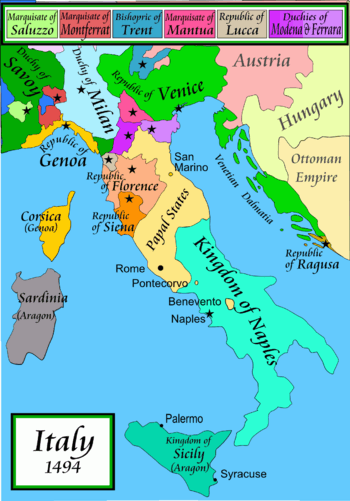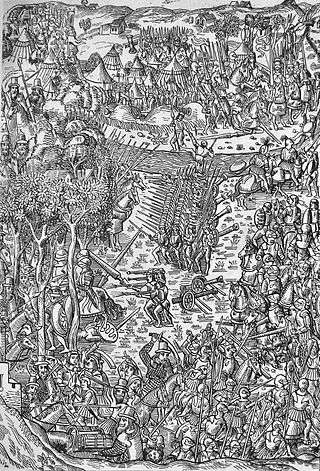Italian War of 1494–98
| First Italian War | |||||||
|---|---|---|---|---|---|---|---|
| Part of the Italian Wars | |||||||
 Italy in 1494 | |||||||
| |||||||
| Belligerents | |||||||
|
League of Venice: | |||||||
| Commanders and leaders | |||||||
|
|
| ||||||
| Strength | |||||||
|
| Unknown | ||||||
| Casualties and losses | |||||||
| 13,000 men[1] | Unknown | ||||||
The First Italian War, sometimes referred to as the Italian War of 1494 or Charles VIII's Italian War, was the opening phase of the Italian Wars. The war pitted Charles VIII of France, who had initial Milanese aid, against the Holy Roman Empire, Spain, and an alliance of Italian powers led by Pope Alexander VI.
Prelude
Pope Innocent VIII, in conflict with King Ferdinand I of Naples over Ferdinand's refusal to pay feudal dues to the papacy, excommunicated and deposed Ferdinand by a bull of 11 September 1489. Innocent then offered the Kingdom of Naples to Charles VIII of France, who had a remote claim to its throne because his grandfather, Charles VII, King of France, had married Marie of Anjou[2] of the Angevin dynasty, the ruling family of Naples until 1442. Innocent later settled his quarrel with Ferdinand and revoked the bans before dying in 1492, but the offer to Charles remained an apple of discord in Italian politics. Ferdinand died on January 25, 1494, and was succeeded by his son Alfonso II.[3]
French invasion
In October 1494, Ludovico Sforza, who had long controlled the Duchy of Milan, finally procured the ducal title after providing a hitherto unheard-of dowry to his niece, who was marrying the Holy Roman Emperor, Maximilian. He was immediately challenged by Alfonso II, who also had a claim on Milan. Ludovico decided to remove this threat by inciting Charles to take up Innocent's offer. Charles was also being encouraged by his favorite, Étienne de Vesc, as well as by Cardinal Giuliano della Rovere, the future Pope Julius II, who hoped to settle a score with the incumbent Pope, Alexander VI.
Charles VIII gathered a large army of 25,000 men, including 8,000 Swiss mercenaries and the first siege train to include artillery, and invaded the Italian peninsula.[1] He was aided by Louis d'Orleans' victory over Neapolitan forces at the Battle of Rapallo which allowed Charles to march his army through the Republic of Genoa.[4] On 19 October, a contingent of Charles' army besieged the fortress of Mordano. After refusing to surrender, the fortress was bombarded, taken by French-Milanese forces, and the surviving inhabitants massacred.[5]
The arrival of Charles's army outside Florence in mid-November of 1494[6] created fears of rape and pillage. The Florentines were led to exile Piero de' Medici and to establish a republican government. Bernardo Rucellai and other members of the Florentine oligarchy then acted as ambassadors to negotiate a peaceful accord with Charles.
The French finally reached the city of Naples in February 1495, capturing it without a siege or a pitched battle. Charles stayed in Naples for a number of weeks, but on 20 May 1495, with the newly formed anti-French League of Venice threatening to cut off his return through northern Italy, Charles left Naples to return to France.[7] Charles left Gilbert, Count of Montpensier, in Naples as his viceroy, with a substantial garrison of armed men.[8]
The Italian states, however, quickly realized the danger of foreign monarchy to the autonomy of each of them, and in March 1495 they had agreed to create an alliance known as the League of Venice. After Ferdinand of Aragon had recovered Naples, with the help of his Spanish relatives with whom he had sought asylum in Sicily, the army of the League followed Charles's retreat northwards through Rome, which had been abandoned to the French by Pope Alexander VI on May 27, 1495.[9]
League of Venice
The speed of the French advance, together with the brutality of their sack of Mordano, left the other states of Italy in shock. Ludovico Sforza, realizing that Charles had a claim to Milan as well as Naples, and would probably not be satisfied by the annexation of Naples alone, turned to Pope Alexander VI, who was embroiled in a power game of his own with France and various Italian states over his attempts to secure secular fiefdoms for his children. The Pope formed an alliance of several opponents of French hegemony in Italy: himself; Ferdinand of Aragon, who was also King of Sicily; the Emperor Maximilian I; Ludovico in Milan; and the Republic of Venice. (Venice's ostensible purpose in joining the League was to oppose the Ottoman Empire, while its actual objective was French expulsion from Italy.) This alliance was known as the Holy League of 1495, or as the League of Venice, and was proclaimed on 31 March 1495.[10] England joined the League of Venice in 1496. The League was the first of its kind; there was no medieval precedent for such divergent European states uniting against a common enemy, although many such alliances would be forged in the future.[11]
The League gathered an army under the condottiero Francesco II Gonzaga, Marquess of Mantua. Including most of the city-states of northern Italy, the League of Venice threatened to shut off King Charles's land route by which to return to France. Charles VIII, not wanting to be trapped in Naples, marched north to Lombardy on May 20, 1495.[7] There he met the League in the Battle of Fornovo, 6 July 1495.[12] The Battle of Fornovo was an indecisive battle. When the battle was over both sides claimed victory.[13] Despite their numerical superiority in the battle, the League army took twice the casualties that the French army suffered.[14] However, Charles did successfully retreat with most of his army across the territories of his enemies on his way to France and the army of the League could not stop him, but Charles had to abandon nearly all of the spoils from his whole campaign in Italy. Charles VIII died in April of 1498, before he could regroup his forces and return to Italy.[15]
-

French troops under Charles VIII entering Florence, 17 November 1494, by Francesco Granacci
-

French troops and artillery entering Naples in 1495.
-

Battle of Fornovo, 6 July 1495.
References
- 1 2 3 Ritchie, R. Historical Atlas of the Renaissance. p. 64.
- ↑ Mallett, Michael; Shaw, Christine (2012). The Italian Wars: 1494–1559. Harlow, England: Pearson Education Limited. p. 8.
- ↑ Mallett and Shaw (2012), p. 14
- ↑ Mallett and Shaw, p19
- ↑ Mallet and Shaw, p.19-20
- ↑ Mallett and Shaw (2012), p. 22
- 1 2 Michael Mallett and Christine Shaw, The Italian Wars: 1494-1559, p. 28.
- ↑ Mallett and Shaw (2012), p. 28
- ↑ Mallett and Shaw (2012), p. 29
- ↑ Mallett and Shaw (2012), p. 27
- ↑ Anderson, M. S. (1993). The Rise of Modern Diplomacy 1450–1919. London: Longman. p. 3. ISBN 0-582-21232-4.
- ↑ Mallett and Shaw (2012), p. 30
- ↑ Guicciardini, Francesco. "Storia d'Italia". Retrieved 20 March 2014.
- ↑ Mallett and Shaw (2012), p. 31
- ↑ Mallett and Shaw (2012), p. 38